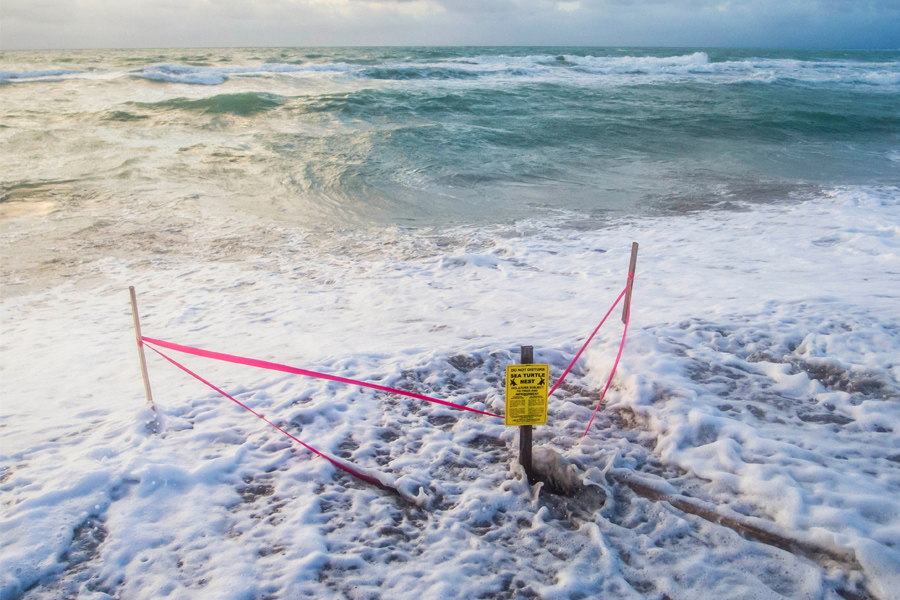How Is Climate Change Affecting Sea Turtles

A research team led by Florida State University found that body of water turtles in the U.S. volition have less suitable nesting habitat in the future because of climate change and littoral development.
Researchers institute areas that will remain or become suitable for ocean turtle nesting in the future because of climatic changes and sea-level rising will be exposed to increased coastal development, hindering the power of turtles to adapt to these disturbances. Their work was published in the journal Regional Environmental Change.

"A reduction in available nesting habitat coupled with the pressures associated with coastal development could likely have detrimental impacts on the reproductive output of body of water turtle nesting areas in the U.Southward. and population stability," said Mariana Fuentes, an associate professor of oceanography in the FSU Department of Earth, Ocean and Atmospheric Scientific discipline and the study'south atomic number 82 author.
The researchers modeled suitability of coastal habitats in the eastern U.Due south. by 2050 for loggerhead, greenish and leatherback sea turtle nesting, considering predicted body of water-level rise and time to come climates.
The results differ for specific places and species, but the overall picture is one of decreases in suitable nesting grounds and increasing pressure from littoral evolution.
Loggerhead turtles will come across a decrease of well-nigh ten percent in suitable nesting areas, with deteriorating conditions in Florida, South Carolina and North Carolina. Green turtles will see some improved nesting habitat in southwest Florida, simply less suitable habitat elsewhere in the state and the Carolinas. Overall, greenish turtles will see a decrease of about 7 percent in suitable nesting habitat along the U.S. East Declension. Leatherback turtles won't meet major changes in the broad availability of suitable areas.
A changing climate, rising sea levels and coastal evolution each play a role in determining the availability of suitable nesting habitats in the hereafter.
Sea turtles demand certain climate atmospheric condition for egg incubation, and a irresolute climate will mean dissimilar conditions for precipitation and temperature. Sea-level rise is another factor. It is projected to submerge nearly 80 per centum of current habitat that is predicted to have a suitable climate for future egg incubation.
But sea-level rise is as well projected to create new beaches. In fact, a 0.5-meter body of water-level rise (a conservative estimate) is predicted to consequence in a internet habitat gain for the bounding main turtle species the researchers studied. Withal, coastal development will be an issue in most of those areas, which volition impact how well they function as nesting sites.
Researchers found a few regions in North Carolina and South Carolina that are projected to accept loftier or very high climate suitability for sea turtle egg incubation, trivial risk from sea-level rise and no substantial housing growth, which will make them optimal nesting habitats. Identifying these areas could inform management and conservation policies.
In other places where development is expected to add pressure to bounding main turtles, management strategies, such as turtle-friendly lighting, removing beach debris and not disturbing nesting areas, will assist minimize additional impacts of human activity on these animals.
"Ocean turtles have existed for millions of years, and they have persisted through dramatic changes in climate in the past," Fuentes said. "They accept the ability to adapt to irresolute conditions, but coastal evolution and the unprecedented speed of electric current climate alter are things they have never had to deal with, which may hinder their power to adapt to the future."
Researchers from the U.S. Fish and Wildlife Service, Florida Fish and Wildlife Conservation Commission, North Carolina Wild fauna Resource Committee, the Padre Island National Seashore Partition of Bounding main Turtle Science and Recovery, Academy of Wisconsin-Madison, Deepwater Horizon Gulf Restoration Office, South Carolina Department of Natural Resource and the National Audubon Society contributed to the written report.
Source: https://news.fsu.edu/news/science-technology/2020/08/25/coastal-development-changing-climate-threaten-sea-turtle-nesting-habitat/
Posted by: kingtordese.blogspot.com

0 Response to "How Is Climate Change Affecting Sea Turtles"
Post a Comment